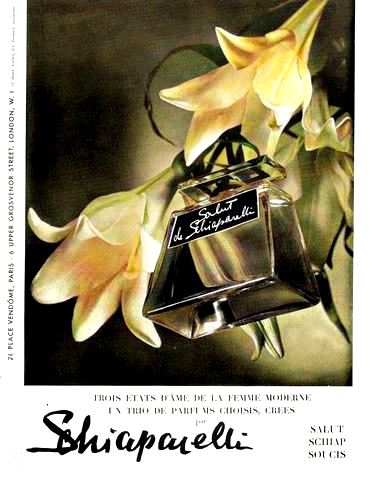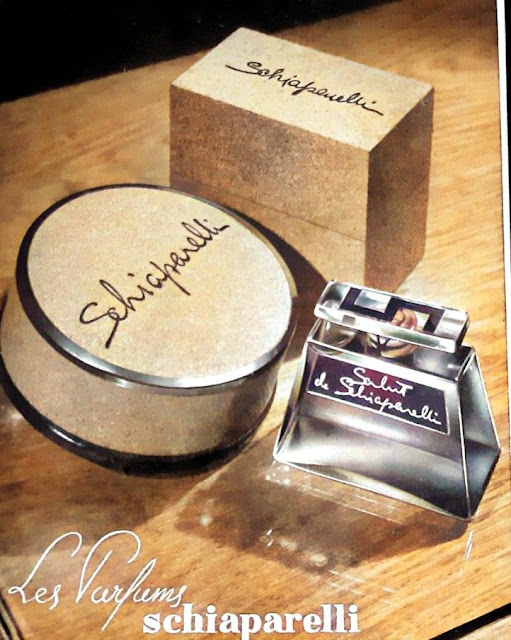Fragrance Composition:
So what does it smell like? Salut by Schiaparelli is classified as a floral chypre fragrance for women. The overall effect is vibrant, sharp, crisp, and fresh, green with a slight medicinal tone. A romantic chypre very heavy on the lily of the valley!
- Top notes: aldehyde C-9, aldehyde C-10, cyclamen aldehyde, Tunisian neroli, Calabrian bergamot, Ceylon citronella, Egyptian geranium, Bulgarian hyssop, Persian galbanum, Spanish rosemary
- Middle notes: Alpine lily of the valley, lilial, hydroxycitronellal, linalol, Zanzibar clove, Grasse jasmine, Madagascar ylang ylang, Chinese gardenia, Dutch narcissus, Dutch hyacinth, Florentine orris and Indian tuberose
- Base notes: terpineol, ambergris, Brazilian rosewood, Mysore sandalwood, Yugoslavia oakmoss, Haitian vetiver, Sumatra benzoin, Maltese labdanum, Canadian castoreum, Tonkin musk, Venezuelan tonka bean
Scent Profile:
To experience Salut by Schiaparelli is to embark on a spirited promenade through a garden in spring, one with wild edges and sudden shafts of sunlight piercing dense green foliage. This floral chypre opens with an exhilarating rush of bright, crisp, almost effervescent top notes—each one contributing to the fragrance’s invigorating sharpness and green sparkle.
The aldehydes—specifically C-9 and C-10—are among the first to register. These synthetics lend an abstract brightness, akin to starched linen in sunlight or champagne bubbles dancing at the surface of a coupe. Aldehyde C-9 has a waxy, citrusy sweetness, while C-10 brings a fatty-clean freshness, smoothing the transition to the herbal and citrus oils. Cyclamen aldehyde, more floral and aquatic in nature, evokes crushed petals floating in a mountain spring—its cool, ozonic effect lifts the entire opening.
Then, the natural elements begin to assert themselves. Tunisian neroli, distilled from orange blossoms basked in Mediterranean sun, contributes its honeyed green-floral edge—neroli from Tunisia is especially prized for its balance between floral sweetness and bitter orange zest. Calabrian bergamot lends its refined, sparkling citrus peel aroma—less sharp than lemon, more elegant, with nuances of lavender and tea. Ceylon citronella, often overlooked in perfumery, brings a brisk, lemony-herbal sharpness—clean and piercing like sun on metal. Egyptian geranium hums with green rose and mint tones, while Bulgarian hyssop—an herb not commonly found in modern blends—adds a resinous, camphoraceous breath, both cool and aromatic. Persian galbanum, rich and bitter-green, floods the senses with the scent of sap and crushed leaves, grounding the top notes with a vegetal earthiness. Spanish rosemary, pungent and sharp, adds a medicinal briskness, like a fleeting touch of tonic on the skin.
The heart of Salut blooms suddenly—lush and romantic, yet never sweet. Alpine lily of the valley, its presence unmistakable, dominates with that dewy, green floral character so reminiscent of freshly picked stems after rain. To build this illusion, perfumers relied on a blend of synthetics: Lilial, which mimics lily of the valley with its sweet, light-clean floral scent; hydroxycitronellal, dewy and soft, expands the illusion of wet petals; and linalol, floral with a slightly woody-citrus nuance, ties the bouquet together with understated elegance.
These synthetics heighten and clarify the natural floral ingredients. Zanzibar clove warms the composition ever so slightly, peppery and comforting, like sunlight filtering through the petals. Grasse jasmine, the gold standard in floral raw materials, brings a narcotic depth—honeyed, indolic, and alive. Madagascar ylang ylang follows, lush and banana-creamy, blending tropical sensuality with a faint medicinal trace. Chinese gardenia and Dutch narcissus lend narcotic white florals with green stems still attached. Dutch hyacinth deepens the green theme, blue and metallic and cool. Florentine orris, precious and powdery, smells of violet and suede, softly blurring the florals like a gentle breeze. Indian tuberose, creamy and heady, pulses beneath everything like a heartbeat.
The drydown is a masterclass in chypre elegance, its components each anchoring Salut in richness and shadow. Terpineol provides a woody, pine-laced cleanliness, bridging the floral heart to the darker base. Then, ambergris—or its accord—emerges: salty, animalic, and sensual. Brazilian rosewood, now rare, contributes a deep, rose-like woodiness tinged with spice. Mysore sandalwood, once the soul of countless perfumes, lends its uniquely creamy, milky, sacred aroma—warm, deep, and velvety smooth. Yugoslavian oakmoss carries the unmistakable scent of wet forest floor: earthy, slightly bitter, damp with shade and moss. Haitian vetiver, smoky and rooty, curls around the moss like fine tobacco.
Sumatra benzoin sweetens the composition slightly, its vanilla-balsamic warmth like golden syrup over wood. Maltese labdanum, sticky and resinous, adds depth with its leathery, incense-like richness. Then come the animalics: Canadian castoreum, dark and slightly smoky with leathery musks; Tonkin musk, elusive and deeply sensual, a whisper of skin and desire; and finally, Venezuelan tonka bean, with its coumarin-laced powderiness, folding it all into a soft, faintly nutty finish.
In total, Salut feels like a salute in the most elegant sense—a scented gesture of presence and vitality. It is a perfume that announces a woman not with loudness, but with clarity, freshness, and sophistication. Her entrance, like the fragrance itself, is poised and luminous, trailing a complex harmony of floral-green notes that promise both sharp intelligence and undeniable charm.








No comments:
Post a Comment